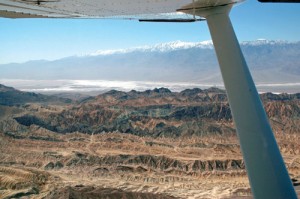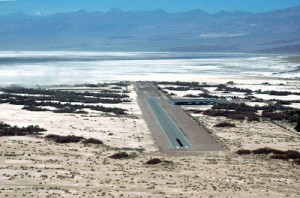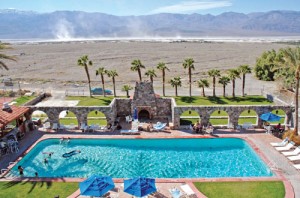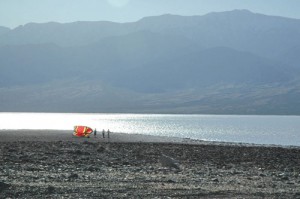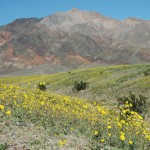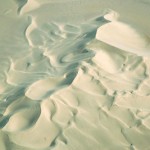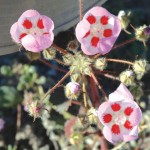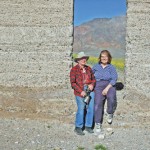By Greg Brown
When celebrating birthdays with zeros in them, flowers alone won’t do it. So when Jean marked a new decade this March, I sought a worthy weekend getaway. With most places still wintry, it made little sense leaving balmy Phoenix for somewhere frigid. But then I remembered our wish-list destination of Death Valley, Calif., tolerable only in winter when everywhere else is too cold. I phoned for a room.
“Sorry,” said the agent. “We’re booked up for Saturday night. Thanks to record rains, everyone’s coming for the biggest wildflower season in years.” He offered a room for Sunday.
“Seems weird celebrating a birthday in Death Valley,” said Jean, but tantalized by those flowers, she arranged Monday off from work. Sunday morning we sailed two and a half hours westward from Phoenix, escaping rain and icy clouds for increasingly barren terrain.
Bypassing Las Vegas, we descended over the desolate Funeral Mountains into a moonscape of salt flats and mineral-tinted rock. There we spotted Furnace Creek Airport next to a tiny palm-studded rectangle, the only visible green in all of Death Valley. Our altimeter on downwind indicated 600 feet—field elevation here is minus 210 feet.
“This place is scary,” said Jean when we landed. Nary a blade of grass could be seen, and nearby dust devils swirled white with salt. Hoping I hadn’t blown it, I loaded our bags into the courtesy van. Fortunately, our destination offered haven. Nestled like an emerald fortress against the brutally empty desert, the 1927 Furnace Creek Inn welcomed us with palm trees and a swimming pool.
“Shall we try a hike?” I asked Jean, eyeing bleakness beyond the fence.
“Sure Greg, why not,” was her reply.
The nearest hiking trail, however, proved to be several miles away. With no rental cars available, we decided to hitchhike. That raised eyebrows at the front desk, but we figured that a hundred miles from nowhere, drivers here could only be sightseers like us.
Squinting under an unrelenting sun, we stuck out our thumbs. Only six or seven cars had passed when an aging Taurus wagon pulled over. Behind the cracked windshield rode a cheerful, middle-aged woman and an elderly man wearing a safari hat. Exchanging hellos, we embarked on those uncomfortable moments when new acquaintances ponder what they’ve gotten into.
“I’m Jane McEwan,” said the driver. “This is my father, Bill. Did your car break down?”
Jean explained that we’d flown here by light plane, and were bound for the Golden Canyon Trail.
“You’re pilots, eh?” said Jane, “My friend Dan flies a Piper Arrow, and I’ve just subscribed to something called Flight Training magazine.”
Bill chimed in, “I used to fly gliders, even built some myself.”
Jean and I swapped glider-flying tales with the man. Though each of us had first soloed in Schweizer 2.22s, Bill had far surpassed our own soaring accomplishments. He flew among record-setting soaring pioneers around Inyokern, Calif.
“There’s the trailhead,” I observed, disappointed that our promising conversation would prematurely end.
“Are you here to see wildflowers?” asked Jane. “That trail is geologically interesting, but there’ll be few blossoms. Dad and I are driving to where the big show is supposed to be, 40 miles south of here. Care to join us?”
“You bet!” replied Jean and I in unison. We soon learned that Bill and Jane had driven from Ridgecrest, Calif., on a father-daughter daytrip to celebrate Bill’s own milestone.
“I’ll be 90 next week,” he explained.
Bill was a Rhodes scholar at Oxford when the Germans bombed England in 1940. Evacuated home, he earned a PhD in physical chemistry from Harvard before serving in North Africa and Italy. After the war, he developed rocket propellants at China Lake Naval Ordnance Test Station for the early aircraft missile programs.
Next thing I knew, Bill was swapping molecular formulas for various drug families with Jean, a doctor of pharmacy. His business card, however, identified him as a sculptor.
“Did you carve that beautiful bola tie?” asked Jean. He had. Another of Bill’s passions explained his love for flowers.
“Growers know my invention for propagating orchids, the McEwan Flask,” he said.
Out the window, people were wading at Badwater, the lowest point in the Western Hemisphere, at minus 282 feet.
“Is there always water in this lake?” asked Jean.
“First time I’ve ever seen water in it,” replied Bill.
No wonder—with annual rainfall of less than two inches and daytime July temperatures averaging 115°F, Death Valley is the driest and hottest place in North America. Our toasty hometown of Phoenix seemed almost artic in comparison.
Jane steered for a roadside patch of color. An environmental attorney, her background is as a naturalist.
“You pilots will appreciate this ‘parachute plant,'” she said. “Note the silky blossoms blowing like chutes in the wind, while the leaves lay flat against the ground.”
Nearby she identified purple Desert Sand Verbena, and pink Desert Five Spot with its trademark splashes of crimson. The biggest show, however, greeted us at the Ashford Mill ruins. There, in warm sunlight, hovered a breathtaking carpet of Desert Gold wildflowers between stark walls of multi-hued rock.
Returning to Furnace Creek, we topped the fuel tank for our newfound friends and headed poolside for a dip. How incongruous it seemed, in this desert oasis isolated by hundreds of miles of uninhabitable salt and rock, toasting life that evening over gourmet chile-dusted salmon and orange-and-horseradish halibut.
“It was a wonderful birthday,” said Jean as we turned homeward next morning. She kissed me, then pointed downward at a single splatter of blossoms tinting otherwise bleak barrens. “But let’s not come back in summertime.”
Two days later the press would trumpet the biggest Death Valley wildflower explosion in 100 years, and no more rooms would be available there for months. I guess Jean got birthday flowers after all.
Author of numerous books and articles, Greg Brown is a columnist for AOPA Flight Training magazine. Read more of his tales in “Flying Carpet: The Soul of an Airplane,” available through your favorite bookstore, pilot shop or online catalog, and visit [http://www.gregbrownflyingcarpet.com].
- Desert Gold wildflowers contrast with mineral-hued rock near the Ashford Mill ruins.
- Fields of Desert Sand Verbena tint the normally bleak landscape.
- Above: Huge sand dunes mark our exit from Death Valley (note campers at far left of photo).
- Petals of the Desert Five-Spot reveal delicate inner beauty.
- Bill and Jane McEwan brighten a crumbling doorway at the Ashford Mills ruins.












